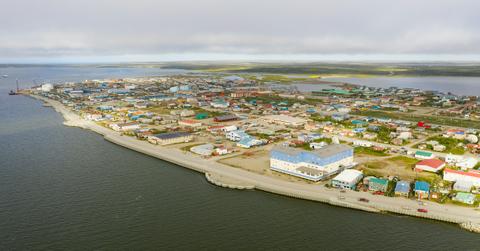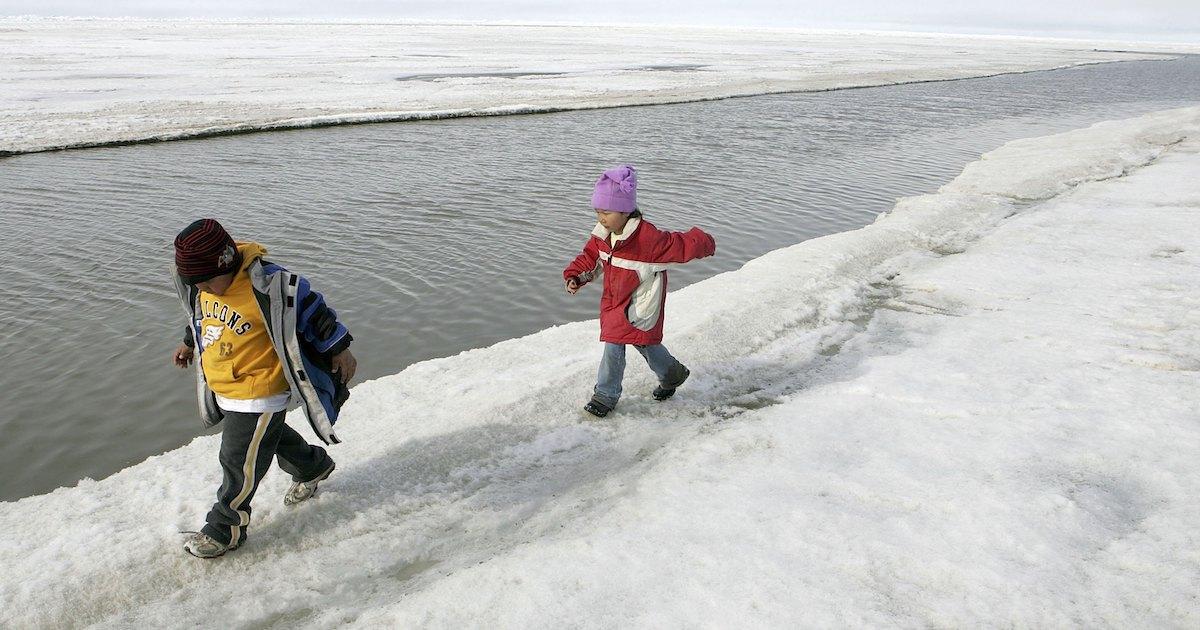How Kotzebue, Alaska Became Known as the Country's "Most Toxic Town"
Published March 14 2023, 2:30 p.m. ET

Located 26 miles north of the Arctic Circle, the town of Kotzebue, Alaska lies on a sand spit in the Baldwin Peninsula and serves as a transfer point for shipping. Surrounded by parks and preserves, nature plays an important role in the day-to-day life of the people in Kotzebue. About 70 percent of the residents are native Iñupiat people who have inhabited the area for nearly 9,000 years and still rely on subsistence harvests, hunting, and fishing.
In fact, Kotzebue is believed to be the oldest settlement in all of North and South America. Yet, year after year, Kotzebue makes headlines for another reason: its proximity to the Red Dog Mine, one of the world’s largest zinc and lead mines, that’s considered to be the biggest chemical polluter in the U.S.

Children play along the banks of the frozen Arctic Ocean June 7, 2006 in Browerville, Alaska.
What is the Red Dog Mine? Its polluting the Alaska town of Kotzebue.
Opened in 1989 and operated by parent company Teck, the Red Dog Mine is situated 90 miles north of Kotzebue between the Cape Krusenstern National Monument, a bear, moose and migratory bird habitat; and the 6.6-million-acre Noatak National Preserve, a home for other wildlife like caribou, brown bears, muskox, and Dall sheep.
The Red Dog Mine sits on land owned by NANA, the Native corporation for Northwest Alaska, an organization that consists of 15,000 Indigenous shareholders. According to an article from the Anchorage Daily News, some tout the mine as a success story bringing jobs to the community and maintaining standards of the Clean Air Act, while others say it’s the source of pollution in waterways.
Residents in the tiny village of Kivalina, Alaska have long claimed (and contested in court) that the mine is contaminating drinking water, as well as hunting and fishing grounds. In 2001, elevated levels of heavy metal deposits were confirmed in the tundra and moss along the Mine Haul Road, which runs through the Noatak National Preserve.
How toxic is the Red Dog Mine?
Each year, the EPA issues its updated dataset for its Toxic Release Inventory, a mandatory program that requires industrial facilities to disclose chemicals being released into nearby air, water, or land. In 2021, the total releases at the Red Dog mining facility were 601.7 million pounds – accounting for 85 percent of the chemical releases in the entire state of Alaska.
In comparison, the chemical releases at the Red Dog Mine are around seven times the entire state of Florida, 17 times the state of California, and 40 times the state of New York. According to the factsheets found in the Toxic Release Inventory, the next closest polluter was Nevada with 449.2 million pounds, due in large part to the Goldstrike Mines, which account for 275 million pounds of chemical releases in Nevada.
Here are the top 5 states with the highest release amounts (both on and off site disposals):
- Alaska: 697.8 million pounds
- Nevada: 449.2 million pounds
- Utah: 199.8 million pounds
- Texas: 189.8 million pounds
- Louisiana: 152.6 million pounds
When considering the vast difference between the chemical release amounts of entire states vs. the Red Dog Mine, the numbers are unsettling, to say the least. Much of the releases in the Red Dog Mine consist of lead, manganese compounds, and zinc, and although overall numbers are down slightly since the 2014 and 2017 highs, water releases – which consist primarily of ammonia and zinc – are on the rise.
Even though the town of Kivalina Alaska is closer to the Red Dog Mine (and sees the brunt of the environmental issues) than Kotzebue, Alaska is, the EPA divides its reporting into regions. Based on this system, the closest main town in Northwest Arctic Borough is Kotzebue, and so, it’s been given the title of the “most toxic place in America.”